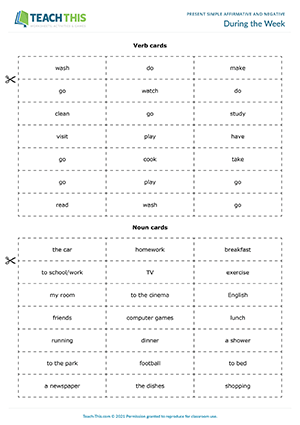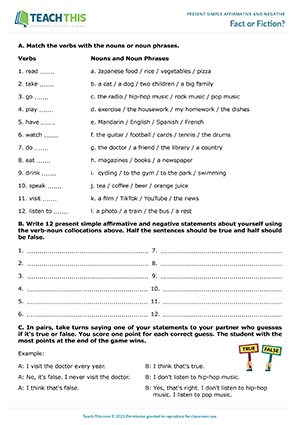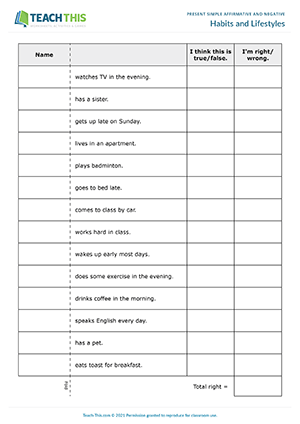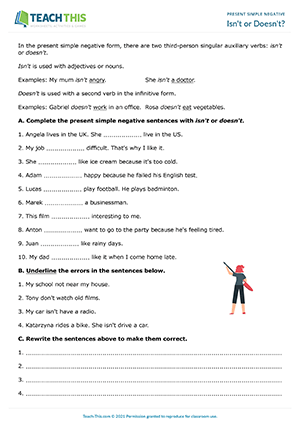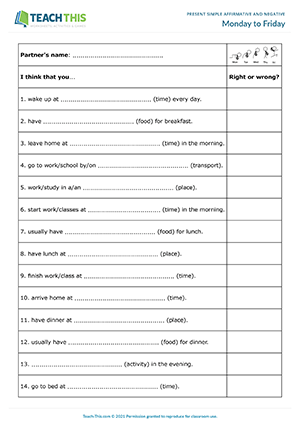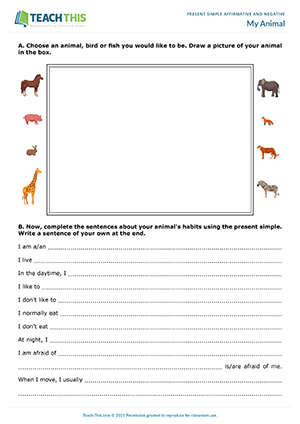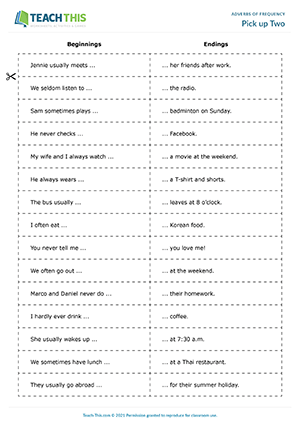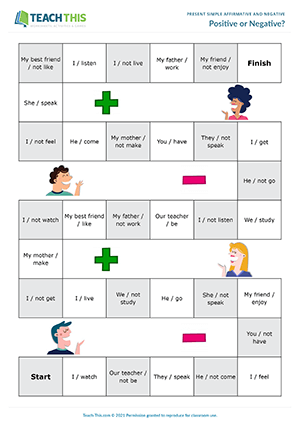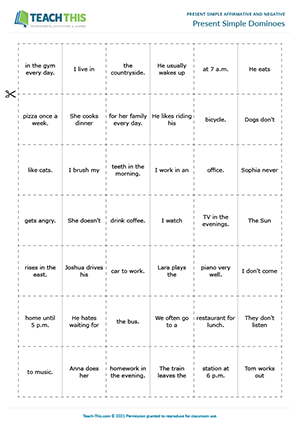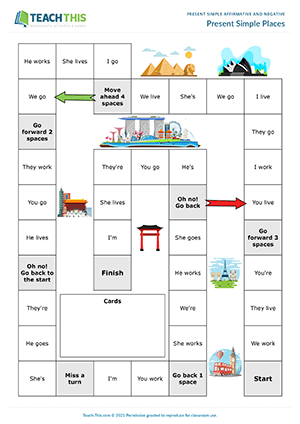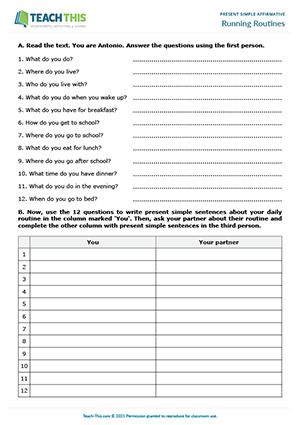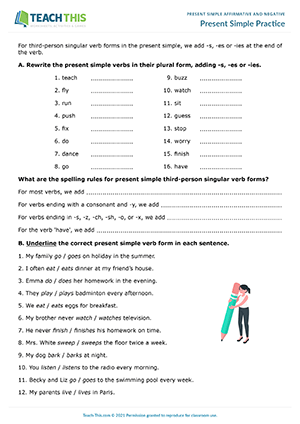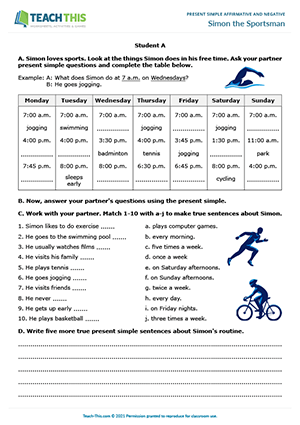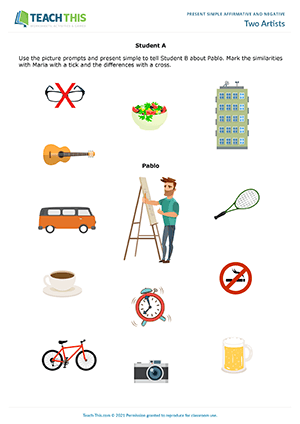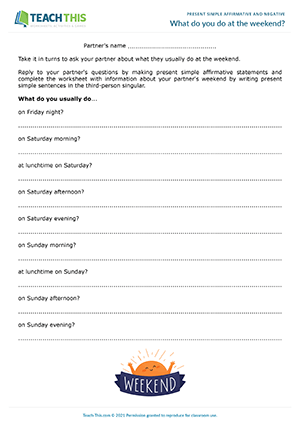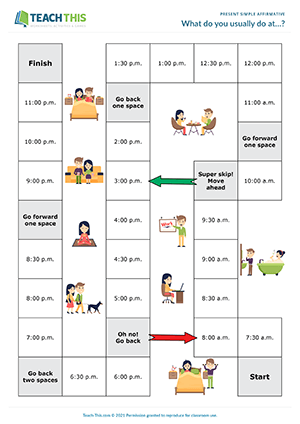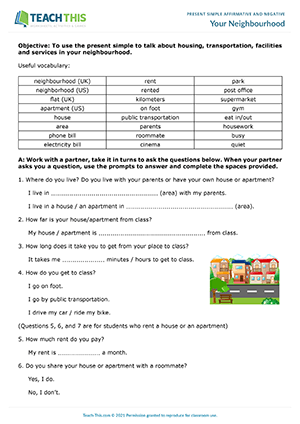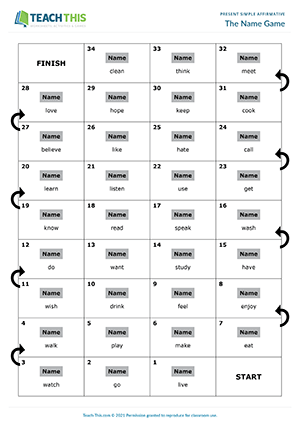In this engaging present simple game, students make affirmative and negative statements about their daily routines. Students put a verb card face-down in each empty square on a chart that shows days of the week and parts of the day. Students then take turns turning over a verb card on the chart. If the verb matches with one of the noun cards in their hand, the student makes a true present simple affirmative or negative statement about what they do or don’t do at that time and day. For example, a student turns over the verb go on the square representing 'Wednesday morning', matches it with the noun cycling and says, "I don’t go cycling on Wednesday morning." If the group agrees that the sentence is grammatically correct and appropriate, the student puts their noun card on top of the verb card. The next student then turns over a verb card, and so on. The first student to get rid of all their noun cards wins the game.
In this free present simple true or false guessing game, students make collocations and then use them in a guessing game where they make true or false present simple affirmative and negative statements. Students begin by matching verbs with nouns or noun phrases on their worksheet. Students then write 12 present simple affirmative and negative statements about themselves using the verb-noun collocations. Half the sentences should be true and half should be false. In pairs, students then take turns reading one of their present simple statements to their partner who decides if it is true or false. Students score one point for each correct guess. The student with the most points at the end of the game is the winner.
In this productive present simple game, students find out about their classmates' habits and lifestyles using present simple affirmative and negative statements. First, students write the names of 14 people in the class in a column. Students then unfold the worksheet to reveal present simple affirmative sentences about the people. Students read each sentence and decide whether it is true or false by putting a tick or cross. Students then find out if their guesses are right or wrong by checking each one with the person who is the subject of the sentence. If students think a sentence is right, they make a present simple affirmative statement, e.g. 'Emma, you watch TV in the evening.' If students think a sentence is wrong, they make a present simple negative statement, e.g. 'Emma, you don't watch TV in the evening.' That person then tells the student if they are right or wrong and gives more information. If students guessed correctly, they put a tick in the last column. If they are wrong, they put a cross. The student with the most correct guesses is the winner.
This useful isn't or doesn't worksheet helps students learn and practice third-person singular auxiliary verbs in present simple negative sentences. Students start by completing present simple negative sentences with isn't or doesn't. Next, students identify errors in present simple negative sentences and correct them. Students then move on to use prompts to make present simple negative sentences with isn't or doesn't. Finally, students use words from a box to complete present simple negative sentences.
In this free present simple speaking activity, students talk about their Monday to Friday routines using present simple affirmative and negative sentences. First, students complete sentences about a partner's Monday to Friday routine by guessing the information and writing it in the spaces provided. Students then take turns reading each sentence to their partner, e.g. 'I think that you wake up at 7 a.m. every day.' Their partner tells them if the statement is right or wrong. If the student's guess is wrong, their partner gives the correct information by first making a present simple negative sentence followed by an affirmative sentence, e.g. 'I don't wake up at 7 a.m. I wake up at 6 a.m. because I go jogging in the park.' The student with the most correct guesses at the end of the activity wins. When the students have finished, they discuss whether they have a lot in common with their partner or not.
This enjoyable present simple worksheet is ideal for teaching young learners the present simple to express habitual actions. In the activity, students take on the role of an animal they would like to be and complete present simple affirmative and negative sentences as if they were that animal. First, students choose one animal they would like to be. Students draw a picture of their animal in a box on the worksheet. Students then complete present simple affirmative and negative sentences about their animal's habitual actions. Students write as if they are the animal using the first person. Students also create one more present simple sentence of their own at the end. Finally, in pairs, students take turns reading their sentences to each other.
In this rewarding present simple game, students match sentence halves together to form basic present simple sentences. In pairs, students start by matching the beginning of each sentence with its respective ending to make a grammatically correct present simple sentence. Pairs score one point for each correct sentence. The pair with the most points wins the game. Afterwards, pairs play a pelmanism game with the cards. Students take turns turning over one card from each set. If the two halves make a grammatically correct present simple sentence, the student keeps the two cards and has another turn. The student with the most cards at the end of the game wins.
In this fun present simple board game, students make true present simple affirmative or negative statements from prompts. Players take turns rolling the dice and moving their counter along the board. When a player lands on a square, they make a true present simple affirmative or negative statement using the prompt on the square. If need be, the player indicates who they are talking about, e.g. 'He doesn't come from Spain.' The other group members listen to the sentence and decide if it is grammatically correct or not. If it is, the player stays on the square. If not, the player must go back two spaces. If players land on the same square, they are not allowed to repeat another student's sentence. The first player to reach the finish wins the game.
This present simple dominoes game helps students practice forming present simple affirmative and negative sentences. The first player tries to make a logical present simple affirmative or negative sentence by placing a domino down either before or after the domino on the table. If the player can make a meaningful sentence, they read it to the group to show the match is correct. The next player then tries to put down one of their dominoes at either end of the domino chain, and so on. The first player to get rid of all their dominoes wins the game.
In this creative present simple board game, students practice making affirmative sentences with prepositions of place. Players take turns rolling the dice and moving their counter along the board. When a player lands on a square, they read the subject pronoun and verb and match it with a place on one of their cards. The player then makes a present simple affirmative sentence, adding in the correct preposition, e.g. 'They work in an office.' If the player's sentence is grammatically correct, they place the card at the bottom of the pile and take one from the top. If the player's sentence is incorrect, they keep the card and go back two squares. The first player to reach the finish wins the game.
Here is a present simple running dictation activity to help students practice present simple sentences and questions about daily routines in the first and third person. One student is the reader and the other is the writer. The reader runs to the text about Antonio's daily routine, reads the first part, tries to remember as much as they can, runs back and dictates it to their partner who writes it down. This continues until the text has been fully dictated. Next, students read the text about Antonio's daily routine and pretend they are Antonio. Students then answer present simple Wh questions as Antonio, writing their answers in the first person. After that, students use the questions to write present simple sentences about their own daily routine. After that, students ask their partner about their routine and complete present simple sentences in the third person.
In this free present simple worksheet, students learn and identify the rules and verb forms associated with the present simple tense. First, students add third-person singular verb endings to verbs (-s, -es or -ies). Students then use the answers to complete spelling rules for third-person singular verb forms. Next, students underline the correct verb forms in present simple sentences and write what they understand about subject-verb agreement in the present simple. After that, students complete present simple affirmative and negative sentences with verbs in brackets and then write the rules for negative verb forms in the present simple. Finally, students rewrite sentences, adding adverbs of frequency and frequency expressions in the correct position. After which, they complete sentences, explaining the correct position of frequency adverbs and expressions in a sentence.
In this present simple information gap activity, students practice making questions and affirmative sentences in the third-person singular together with adverbs of frequency, adverbial time expressions and sports vocabulary. First, in pairs, students complete missing information in a chart about Simon's free-time routine by asking and answering present simple questions with their partner. Next, students match sentence halves to make true present simple sentences about Simon. Finally, students create five more true present simple affirmative sentences of their own about Simon's routine using the information in the chart.
In this imaginative present simple speaking activity, students find out about two people's similarities and differences using picture prompts and the present simple. In pairs, students find out about two artists' similarities and differences. Students use the picture prompts to describe the artist in their picture to their partner using present simple affirmative and negative statements. Students mark the similarities with a tick and differences with a cross.
In this interesting present simple speaking activity, students discuss what they usually do at the weekend. In pairs, students take turns asking their partner about what they usually do at certain times during the weekend. Their partner replies by making a present simple affirmative statement. The student then writes a present simple sentence in the third-person singular about their partner's answer. When the pairs have finished, they discuss how their weekends are different. Finally, students describe their partner's weekend to the class.
In this insightful present simple affirmative board game, students use the present simple tense to describe what they usually do at certain times. Students take turns rolling the dice and moving their counters along the board. When a student lands on a square, the person to their right asks them a What do you usually do at...? question using the time in the square, e.g. 'What do you usually do at 7:30 a.m.?' The student then uses the present simple to describe what they usually do at that time of day, e.g. 'At 7:30 a.m., I usually have a shower.' If a student can’t think of anything to say, repeats a previous sentence, or makes a grammar mistake, they go back two squares. The first student to reach the finish wins the game.
This useful present simple activity helps to teach students how to talk about housing, transport, facilities and services in their neighbourhood. In pairs, students take turns asking and answering questions on the worksheet using the prompts to guide them. Afterwards, students use the vocabulary, questions and answers to create a conversation about their neighbourhood. Finally, pairs present their conversations to the class.
In this compelling present simple board game, students make present simple affirmative sentences and practice pronouncing third-person singular verb forms correctly. Players take turns rolling the dice and moving their counter along the board. When a player lands on a square, they take a name card from the top of the pile. The player then reads out the name on the card and tries to make a true present simple affirmative sentence about the person using the verb marked on the square, pronouncing the third-person singular verb form correctly. The person whose name is on the card tells the player if their sentence is right or wrong. If the sentence is true, the player stays on the square. If the sentence is untrue or the pronunciation or grammar is incorrect, the player goes back two squares. The first player to reach the finish wins the game.
Latest Free
Resources
- Everyday Objects Bingo
Everyday Objects
Elementary (A1-A2)
- Action Verb Races
Actions
Elementary (A1-A2)
- Birthday Basics
Birthdays
Elementary (A1-A2)
- Sales Phrasal Verbs
Business Phrasal Verbs
Upper-intermediate (B2)
Latest Member
Resources
- Collocations at Work
Business Collocations
Intermediate (B1)
- Etiquette Trivia Board Game
Etiquette and Manners
Upper-intermediate (B2)
- Everyday Objects Vocabulary
Everyday Objects
Pre-intermediate (A2)
- Let's have a talk
Verb-Noun Collocations
Pre-intermediate (A2)



